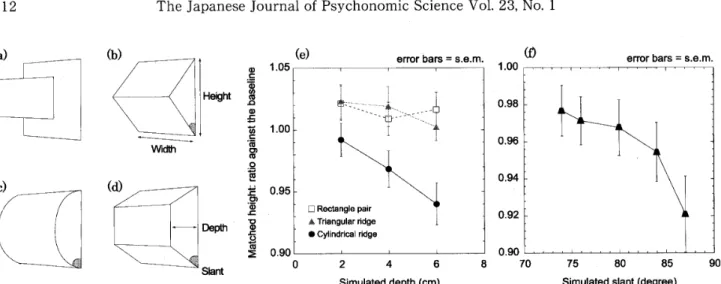The Japanese Psychonomic Society
NII-Electronic Library Service
The JapanesePsychonomic Society
1'heJopan'eseJoumaiofIlsychonomicSeience
2V04,VoL23,N[},1,111-]12
Summary
ofAwardedPresentation2P069
The
efTect
of
3-Dshape
Shuichiro
TAyA
KIv,ushuon
size
perception
and
Kayo
Unit:ersily*MIuRA
Recent studies $uggest thattheshape of three-dimensiona]
(3-D)
objects causes thesystematicdistortionof theirapparent size
(Miura
& Taya, 2001) and we have invcstigatedwhich property ofthe objects may do this.The stirnuli were stereograms
defining
four
3-D
shapes: a pair offrontoparallc]rectangles, a triangular ridge, a cylindrical ridge, and a trapezoidal ridgc. Thc
observcr's task was tomatch the
height
of aEine-drawing
of a rectangle(comparison
stimulus) to thatof thestimuli, The results showedthat
the
apparentheight
ofthe
objectdecreasecl
as thcslantof theirsttrface protruding from the
background
wasincreased.
The results impliedthatour visualsvstern takes account of theslant of a surface forsize estimation. Key words: size perception,surface slanL
3-D
shapcPrcvious studies have reported that observers
made systematic errors when they estimated size
and
depth
in
a3-D
space{Norman,
Todd, Perotti,& Tittle,1996).Most of these studies have attributedtbe
errors toanincorrect
estimation of theviewingdistance,However, recently we demonstrated that
the apparent width of cylindrical objects dccrcased as
their
depth
increased,
indicating
that the3-D
shape causes a systematic error
in
sizc cstimation(Miura
&
Taya, 200D.The goal of the present study was toidcntifythe
factorcausing the systematic
decrernent
of theap-parent size of
3-D
objects, Whenever thc depth of a cylinder changes itsother 3.D properties(slant
and curvature) also change.Therefore,
it
has
notbeen
clear which property critically affects size
percep-tion.In Experiment 1,we examined whether the
depth itselfaffccts apparent size,
We
mea$ured theapparent height of different]yshaped 3-D objeets.
The simulated depths of the objects were
equiva-lentlyset across all shapes,
Therefore,
if
thedepth
itselfwas the factorof the systematic error of size
perception, the apparent heightof theobject wou]d
be dependent on itsdepth but independent of its
shape.
* Department of
Psychology,
Graduate
School
of
Human-Environment Studies, Kyushu
sity,
6-19--21
Hakozaki,
Higashi-ku,
Fukuoka 812-8581
Experiment
1
Method Eight observers participated.The test
stimuli were random-dot stereograms
depicting
oneof three
3-D
shaped objects: a pairoffrontoparallel
rectangles, a triangularridge, and a cylindrical ridge
(Figure
1(a}-(c)),The te$t$timuli had thesarne hori-zontal width<5cm)
but
either of twodifferent
hei-ghts
(4
or 5crn). The simulated depth was 2,4,and 6cm at
the
viewingdistance
of60
cm.A
tine-drawing
of arectangle was presentedbelow
theteststirnulus.An observer's task was to match the height of a
rectangle to that of a test stimulus. To obtain the
baseline
for
normalization a single randomdotrec-tangle of the same width and
height
as the teststimuli was presented inanothcr scssion. The observ-ers again used thesame procedure inanother eight
trialsof the
heighVmatching
taskfor
thisrectangle.Results and Discussion Figure 1(e)shows how
the
apparentheight
varied as a function ofdepth
fer
each of the three shapes.
To
normalize thelarge
indi'vidual
difference,the matchedheight
for
eachstimulus isrepresented as the ratio against the
base-line
value. An analysi$ of variance revealed thatthematched
height
of the cylindersdecreased
as theirdepth increased
(FC2,7)
=27.3,P<
,OOI).
A similardec-rement of matched height was also observed with
the
deepest
(Le.
depth=6
cm) triangularridge.How-ever, the rnatched heights of the rectangular
pairs
The Japanese Psychonomic Society
NII-Electronic Library Service
The JapanesePsychonomic Society
112
TheJapanese
Journal
ofPsychonomlcScience
VoL
23,
No.
1
(a)
r
-'
T
l
(c)
-".-/--l/t1,
'tXx
L-.-(b)
4
-(
-7
x.,.--->s
Vwodtr1 , HeigM
(dl.-r"--(Jlel
Depth SkuTtri.05(e) errerbars=s,e.m. 1.ooo
enrorbars=s.e,m,
2zz8esu.gaenrepp9EoLt8stsE
t.oo O.95 e.go tto
Zde e2 4 6 Simulateddepth(cm) O.98 O,96 O.94 O.92-t-T
Figure 1.
(a)-(d)
Schematic diagrams of thestimuli usedin
thisexperiment. The d"slant"
is
indicated by the arcs fi11edwith gray.(e)
The results of
Experiment
2.
See
text
for
moredetails,
O.90S
7e 75 80 85
Simulatedslant(degree)
efinition of the word
Experiment
1.
(D
The
results ofge
The results suggest that some properties of 3-D shape other than
depth
(e,g,
slant or curvature)af-fectedthe apparent height.In thisexperirnent, the
depth of the objects was equivalent across allof the
shapes,
However,
the
decrement
of height was only observedin
cylindrical ridges and the deepesttrian-gular ridge. Depth therefore,isnot the main
factor
causing thedecrement of the apparent height.
We
presurned thattheslant of asurface protrudingfrom the background affects the apparent
height
(For
the definitionof "slant",see Figure 1).The slant
of tbe cylinder was much steeper
than
that
of thetriangularridge or the pairof rectangles even ifthe
depth of the objects was equivalent. Consequently,
we
hypothesized
that
a steeply slanted surfacecaus-es a decrement of theapparent
height,
Wc
examinedthis
hypothesis inExperiment2,
Experiment
2
Method Five observers participated,
The
teststi-muli were random-dot stereograms defininga
trape-zoidal ridge
(Figure
1(d)).
The
depth-to-height
ratio of the ridge was 1:1. Theheights
(and
simulateddepths) used were 4 and 5cm. The horizontalwidth
of theteststimu]i was always 5cm. The simulated slant of the surface against the
frontopara!lel
back-ground was selected
from
74,
76.
80,
84,
and87
degrees,
The
observers participatedin eight blocksof
10
trials.Allother experirnental conditions werethe same as Experirnent 1.
Results and Discussion Figure 1(f)illustrates
how the apparent
height
varied as a function of thesurface slant, An analysis of variance showed that
thepercejved heights of the 3-Dstirnuli decreased as
theirsurface
became
steeper{F(4,4)
:='9.98,
P<.OO1).
The results supported our hypothesis that the slant of the surface of the 3-D objects caused a decre-ment
in
thc apparentheight
ofthem,
Probably
the
reason why only cylinders and the
deepest
triangu-lar
ridge showed a heightdecrementin
Experiment
1
wasbecause
the slant of theirsurface was much steeper than that of other stimuli.The
results sug-gesttherefore, thata slanted surface affects theper-ception of size,and especially when the slant has a certain steepness,
The
results suggestthat
the
visualsystem may take account of the surface slant when
size isestimated. This isLikelybecause thesize isthe extent of the orthogonally projectcdimage of a
sur-face,and thiscan be varied
depending
on the surfaceslant.
References
Miura, K. & Taya, S.2001 New size
illusion-Docs
theincreaseof perceived depth leadto the
decrease
of perceived width?
PercePtion,
30(supplement):22
-23.Norman,
J,
F.Todd,
J,
T.
PerottL
V.
J.
&
Tittle,J.
S.1996 The visual perception of three-dimensional
length.
fournal
of
EmperimentatRsychology:
Hbeman
